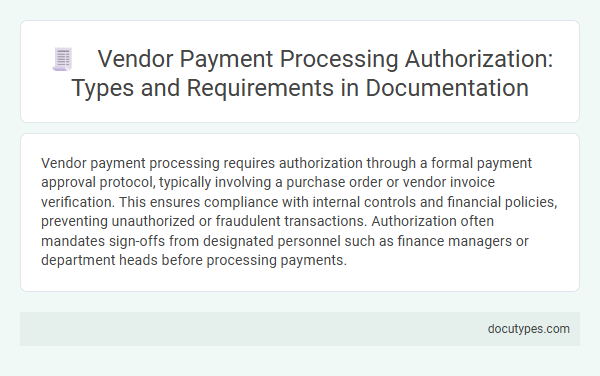Vendor payment processing requires authorization through a formal payment approval protocol, typically involving a purchase order or vendor invoice verification. This ensures compliance with internal controls and financial policies, preventing unauthorized or fraudulent transactions. Authorization often mandates sign-offs from designated personnel such as finance managers or department heads before processing payments.
Introduction to Vendor Payment Processing Authorization
Vendor payment processing authorization ensures that all transactions are properly approved before funds are released. This type of authorization typically requires verification from designated personnel to maintain financial control and prevent unauthorized payments. Understanding your organization's authorization protocols is essential for secure and efficient vendor payments.
Importance of Authorization in Vendor Payments
Authorization for vendor payment processing typically requires approval from designated financial officers or managers within the organization to ensure legitimacy and compliance. Proper authorization establishes accountability and reduces the risk of fraudulent transactions. Securing the correct authorization safeguards company assets and maintains vendor trust by validating payment legitimacy.
Types of Authorization in Payment Processing
Vendor payment processing requires specific types of authorization to ensure security and compliance. These authorizations validate the legitimacy of transactions and protect against fraud.
Common types of authorization include manual approval, automatic system authorization, and multi-level authorization processes. Manual approval involves a designated individual verifying and approving payments. Automatic system authorization uses software algorithms to approve transactions based on preset rules, while multi-level authorization requires multiple sign-offs for higher payment amounts or sensitive transactions.
Manual vs. Digital Authorization Methods
Authorization for vendor payment processing ensures secure and accurate transactions. Choosing between manual and digital authorization methods depends on your organization's workflow and security needs.
- Manual Authorization - Requires physical signatures or handwritten approvals to confirm payment legitimacy.
- Digital Authorization - Utilizes electronic signatures, multi-factor authentication, or automated workflows for faster approval.
- Compliance Requirements - Both methods must align with regulatory standards and internal controls to prevent fraud.
Key Stakeholders in Vendor Payment Authorization
Vendor payment processing requires specific authorization types to ensure financial control and compliance. Approval typically comes from designated key stakeholders within the organization.
Key stakeholders in vendor payment authorization include the finance department, procurement officers, and senior management. These roles validate payment accuracy, budget alignment, and contract adherence before approval.
Required Documentation for Authorization
Vendor payment processing requires specific authorization to ensure secure and compliant transactions. The authorization type typically depends on organizational policies and the payment amount threshold.
Required documentation for authorization includes a formal purchase order, invoice verification, and approval signatures from designated authorities. These documents provide a clear audit trail and validate the legitimacy of the payment request.
Approval Hierarchies and Workflow Structures
| Type of Authorization | Description | Approval Hierarchy | Workflow Structure |
|---|---|---|---|
| Managerial Approval | Authorization required from supervisors or department managers to ensure vendor payments align with budget and policies. | Direct managers or department heads review and approve payments before processing. | Payment requests route to immediate supervisors for approval, then forwarded to finance. |
| Multi-Level Authorization | Multiple layers of approval for high-value payments or sensitive vendor contracts. | Sequential approval from department managers, finance controllers, and executive officers. | Workflow configured to escalate requests through predefined approvers based on payment amount or vendor type. |
| Automated Approval Rules | System-driven authorization based on predefined business rules and spending limits. | Algorithm assigns approver roles according to organizational policy and payment criteria. | Workflow automates routing to appropriate personnel, triggering alerts for exceptions. |
| Compliance Authorization | Authorization ensuring vendor payments comply with legal and regulatory standards. | Compliance officers or internal auditors review payment requests as part of the approval chain. | Integrated workflow includes compliance checks before final payment approval and release. |
| Finance Department Final Approval | Final authorization step by finance team to verify accuracy and fund availability. | Finance managers or controllers authorize disbursement after review of supporting documents. | Workflow culminates in finance department review confirming all prior approvals and documentation. |
Compliance and Audit Requirements in Documentation
What type of authorization is required for vendor payment processing to ensure compliance and audit readiness? Proper documentation must include formal approval from designated personnel and adherence to internal control policies. You need to maintain clear authorization records to meet regulatory standards and facilitate seamless audits.
Common Challenges in Authorization Documentation
Vendor payment processing requires specific authorization types to ensure security and compliance. Identifying these authorization needs is crucial for maintaining accurate financial controls.
- Inadequate Documentation - Missing or incomplete authorization documents create delays and increase the risk of unauthorized payments.
- Complex Approval Hierarchies - Multiple approval levels can cause confusion and hinder timely payment processing.
- Verification Difficulties - Lack of standardized verification processes complicates confirmation of authorized signatories.
Your ability to address these challenges directly impacts the efficiency and reliability of vendor payment authorization.
What Type of Authorization Is Required for Vendor Payment Processing? Infographic

